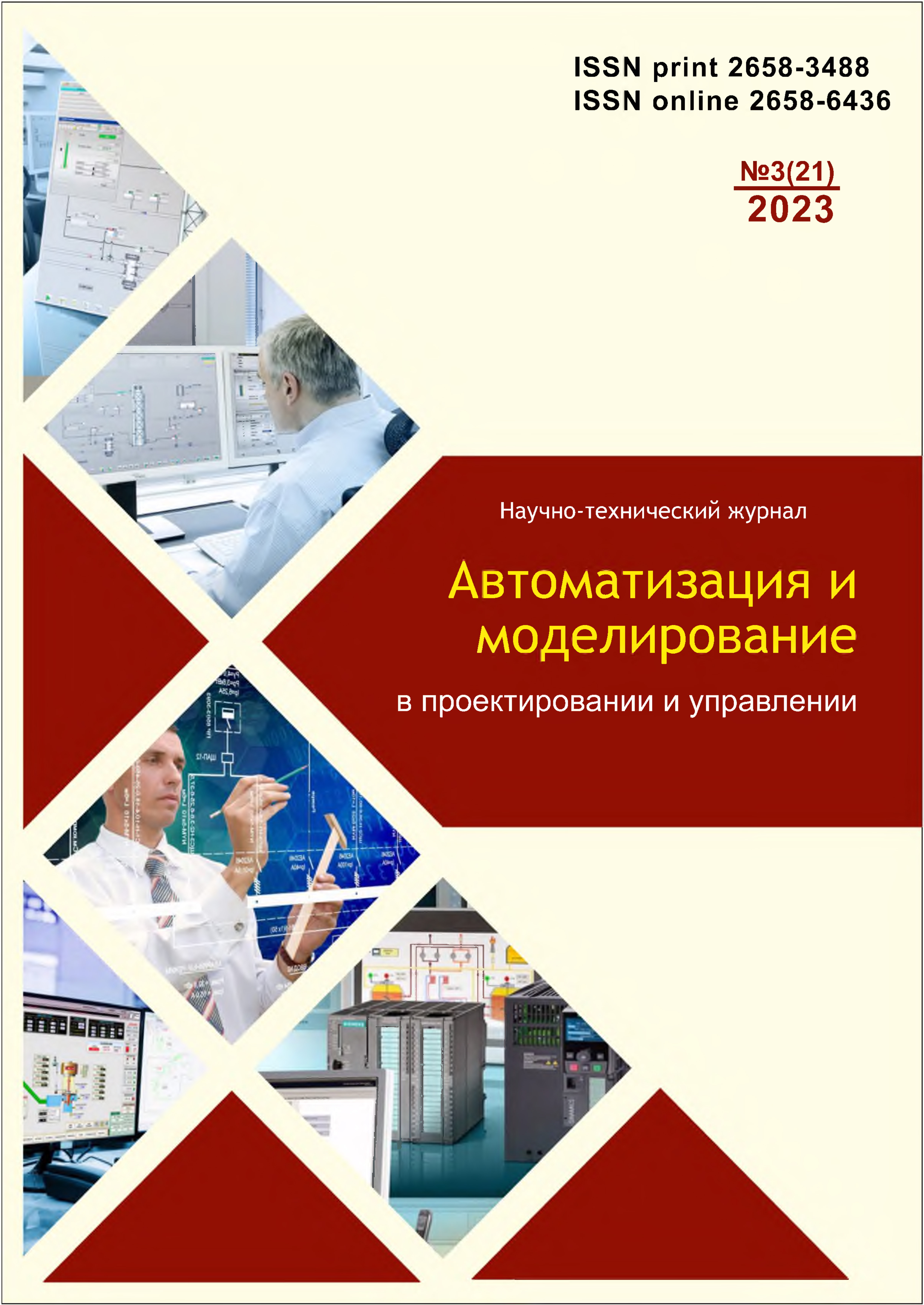Sankt-Peterburg, St. Petersburg, Russian Federation
from 01.01.2019 until now
Sankt-Peterburg, St. Petersburg, Russian Federation
The root-mean-square errors of the position lines are estimated when using direction-finding and difference-range methods based on a matrix receiver with an autocorrelation algorithm at the output. The study compares the accuracy of determining the location of radio emission sources with linear-frequency-modulated and phase-code-shifted signals by a matrix receiver with an autocorrelation algorithm at the output and a matrix receiver with a detector algorithm at the output. A comparative analysis of calculating the ratio between the root-mean-square errors of locating radio emission sources is performed using a matrix receiver with the connection of different algorithms at the output. The study establishes the expediency of using a matrix receiver with an autocorrelation algorithm at the output and a matrix receiver with a detector algorithm at the output for various methods of determining the location of a radio emission source. Findings are given.
matrix receiver, autocorrelation algorithm, detector algorithm, location accuracy, direction-finding method, difference-range method, root-mean-square positioning error
1. Artes-Rodriguez A., Lazaro M., Tong L.Target location estimation in sensor networks using range information // Processing Workshop Proceedings Sensor Array and Multichannel Signal. 2004. P. 608-612. - DOI:https://doi.org/10.1109/SAM.2004.1503021.
2. Zemek R., Hara S., Yanagihara K., Kitayama K.A Joint Estimation of Target Location and Channel Model Parameters in an IEEE 802.15.4-based Wireless Sensor Network // IEEE 18th International Symposium on Personal, Indoor and Mobile Radio Communications. 2007. P. 1-5. DOI:https://doi.org/10.1109/PIMRC.2007.4394355.
3. Patwari N. Locationg the Nodes: Cooperative Localization in Wireless Sensor Networks / N. Patwari, J. N. Ash, S. Kyperountas, A. O. Hero III, R. L. Moses, N. S. Correal // IEEE Signal Processing Magazine. 2005. Vol. 22. No. 4. P. 54-69. DOI:https://doi.org/10.1109/MSP.2005.1458287.
4. Nowak M.J. Co-designed radar-communication using linear frequency modulation waveform / M. J. Nowak, Zhiping Zhang, Yang Qu, D. A. Dessources, M. Wicks, Zhiqiang Wu // IEEE Military Communications Conference. 2016. P. 918-923. DOI:https://doi.org/10.1109/MILCOM.2016.7795447.
5. Jun S., Yu L. The Recognition of Hybrid Modulation Signal Combined with PRBC and LFM // Signal Processing (ICSP). 2012. Vol. 3. P. 1720-1723. DOI:https://doi.org/10.1109/ICoSP.2012.6491912.
6. Richter R., Coutinho O., Pereira T., Ivo F. Linear Frequency Modulation (LFM) Compression in Surveillance Radars: An Alternative for Target Discrimination in a Multi-Threat Scenario // IEEE MTT-S Latin America Microwave Conference. 2018. P. 1-4. DOI:https://doi.org/10.1109/LAMC.2018.8699017.
7. Duong V.M. Detection and Parameters Estimation of Binary Phase Shift Keying Signals in Low Signal to Noise Ratio / V.M. Duong, J. Vesely, P. Hubacek, J. Premysl, N.G. Phan // 21st International Radar Symposium (IRS). 2021. P. 1-11. DOI:https://doi.org/10.23919/IRS51887.2021.9466208. EDN: https://elibrary.ru/ZVATHD
8. Eedara I.P., Amin M.G. Dual Function FH MIMO Radar System with DPSK Signal Embedding // 27th European Signal Processing Conference (EUSIPCO). 2019. P. 1-5. DOI:https://doi.org/10.23919/EUSIPCO.2019.8902743.
9. Nhan N.T., Podstrigaev A.S., Nghi T.H. A Mathematical Model for Determining the Type of Signal Modulation in a Digital Receiver with Autocorrelation Processing // IEEE Conference of Russian Young Researchers in Electrical and Electronic Engineering. 2021. P. 1650-1654. DOI:https://doi.org/10.1109/ElConRus51938.2021.9396097. EDN: https://elibrary.ru/WMITWT
10. Nhan N.T. Podstrigaev A.S., Nghi T.H. Estimation of the Computational Complexity of the Algorithm for Determining the Type of Signal Modulation in the Autocorrelation Receiver // IEEE Conference of Russian Young Researchers in Electrical and Electronic Engineering. 2021. P. 1655-1658. DOI:https://doi.org/10.1109/ElConRus51938.2021.9396254. EDN: https://elibrary.ru/LMKRVU
11. Likhachev V.P., Veselkov A.A., Nguyen Ch. Nh. Characteristics of Detecting Linear-Frequency-Modulated, Phase-Code-Shifted and Simple Radio Pulses in an Autocorrelation Receiver. Radiotekhnika. 2018;8:71-76. DOI: https://doi.org/10.18127/j00338486-201808-14; EDN: https://elibrary.ru/YIZJJR
12. Wilson D.L., Wayman J. L. Signal detection by detecting departure from noise // IEEE Sixth SP Workshop on Statistical Signal and Array Processing. 1992. P. 118-121. DOI:https://doi.org/10.1109/SSAP.1992.246862.
13. Besson O., Scharf L.L., Vincent F. Matched direction detectors and estimators for array processing with subspace steering vector uncertainties // IEEE Trans. Signal Process. 2005. Vol. 53. No. 12. P. 4453-4463. - DOI:https://doi.org/10.1109/TSP.2005.859336.
14. Wang C., Liu W., Jiang M. A Unified Approach for Target Direction Finding Based on Convolutional Neural Networks // IEEE 30th International Workshop on Machine Learning for Signal Processing. 2020. P. 1-6. DOI:https://doi.org/10.1109/MLSP49062.2020.9231787.
15. Liu M., Chen H., Qiu Z., Ren X. Moving Target Location Method Based on Euclidean Distance and Camshift Algorithm // Eighth International Conference on Instrumentation & Measurement, Computer, Communication and Control. 2018. P. 558-563. DOI:https://doi.org/10.1109/IMCCC.2018.00123.
16. Lee J. Performance Verification of a Target Tracking System With a Laser Rangefinder / J. Lee, S. Lee, Y. Lee, Y. Kim, Y. Heo, T. Yoon // IEEE Access. 2021. Vol. 9. P. 30993-31009. DOI:https://doi.org/10.1109/ACCESS.2021.3060061.











